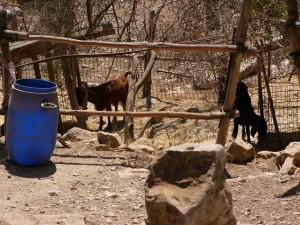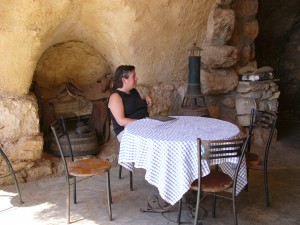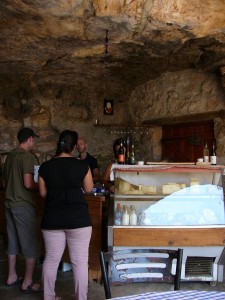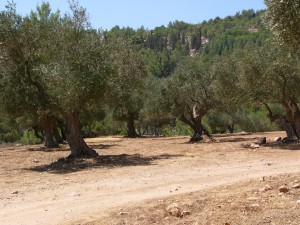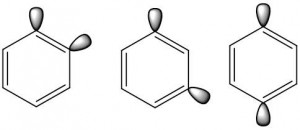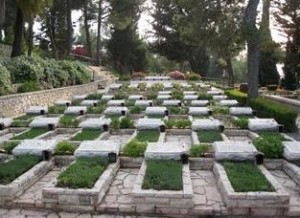A few weeks ago, we visited a highly touted local cheese farm – Shai Seltzer Goat Farm. Many in the region covet this cheese. The owner, Shai Seltzer, is a legend in Israel and is written up in all of the tour books as being a bit of a character; a genius with goats and cheese, standoffish to tourists and somewhat of a hermit. The farm was hard to find – it’s nestled inside a national forest and you have to follow the signs with a small goat on it. It’s like Seltzer doesn’t want anybody to know where his farm is located. But we did find it – up a narrow dirt road that looks like it’s going nowhere. Than we noticed the goat pens built into the hillside and a number of old wooden outbuildings. It was interesting; and we’re venturesome, so we meandered up the hill past the goat sheds to the “store.”
Whoa, what a store. It’s carved out of the rock of the mountain with one table and one small counter with a refrigerated cheese display. Another couple was just finishing up their purchases. The couple behind the counter was Seltzer’s son and daughter-in-law. They had a half dozen or so cheeses to offer as samples – from the soft to the very hard (aged 2-years). Taste? Each morsel was a burst of flavor; nutty, creamy, pungent, semi-sweet, sweet, earthy …… As we were buying what we liked (actually we liked them all) who but Mr. Seltzer comes wandering into the cave (I mean store). In the first two minutes of our encounter, he lived up to his reputation. He was thin, tanned, about 65-75 and sported a long snow white beard, wore a white tunic and white cap (sorry, no photo). As he was talking to his son, Carol mentioned that we admired his goats and had read that they were the offspring of a male goat from Virginia. Suddenly his demeanor changed. We talked about his goats, their lineage, what kind they were (Anglo-Nubian), how his wife learned goat husbandry in Charlottesville (She was born in the US (Shai might have been too) and did her undergraduate work at Bryn Mawr), etc. He even offered us a drink. After 10 or so minutes, off he went. Very strange, very interesting, very very good cheese!
Carol at a table in the store
Carol admiring the goats
The son packaged the cheeses in waxed paper and aluminum foil so they would stay cool as we headed back to Jerusalem (about a 45 minute ride). On the way out of the farm we stopped to photograph the ancient olive trees by the side of the road.
Two customers buying cheese
Very old olive trees on the way to (from) the goat farm


